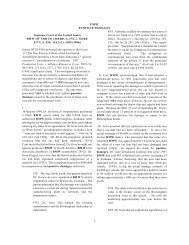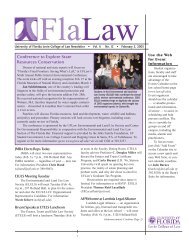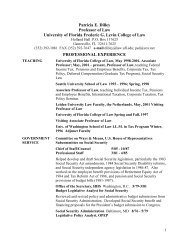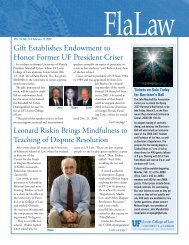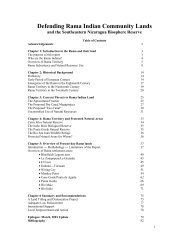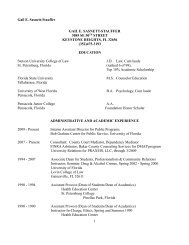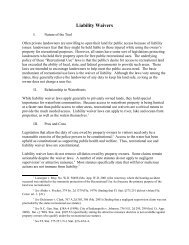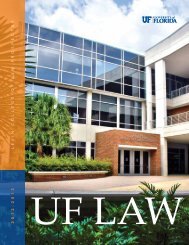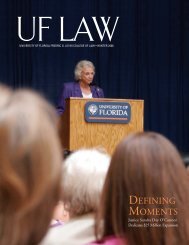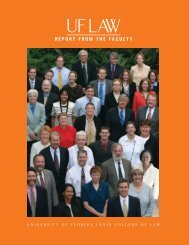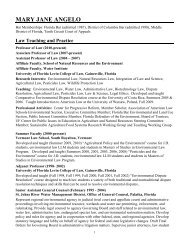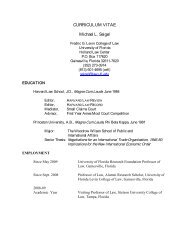David Boies, Douglass, Zack andcounsels for Harris). “Since 2000,there have been a series <strong>of</strong> statutoryresponses that, if there was a recount,would make it much more streamlined,standardized and easier to conduct.”After the embarrassment <strong>of</strong> its2000 presidential election experience,the state passed the <strong>Florida</strong> ElectionReform Act <strong>of</strong> 2001, directly addressinginadequacies in state law regardingvoting and tabulation problems.The act outlawed the venerablecomputer punch card machines aswell as lever and manual paper votingsystems — effectively banishing thehanging chad to history. Instead, theact recommended electronic votingsystems, and mandated all votingsystems must be certified by thesecretary <strong>of</strong> state before the canvassingboards can use them.Initially, both optical-scan andATM-style touchscreen systemsreplaced the old voting machines.Concerns that the touchscreen systemwas vulnerable to s<strong>of</strong>tware glitches orhacking, combined with the lack <strong>of</strong> apaper trail for ballot recounts, led Gov.Charlie Crist to ban its use in 2007after the machine recorded 18,000undervotes in a hotly contested 2006Sarasota County congressional race.Optical-scan machines, which tabulatethe vote electronically but provide apaper record <strong>of</strong> each vote, are now thestandard in use statewide. The opticalscanmachines also alert voters if theyhave recorded over- or undervotes asthe ballot is scanned, giving the voteropportunity to correct his or her ballotbefore leaving the polling place.The <strong>Florida</strong> Election Reform Actalso implemented more uniform ballotdesign, and instructed the secretary <strong>of</strong>state’s <strong>of</strong>fice to standardize interpretation<strong>of</strong> ballot marks and mismarks todetermine “clear indication that thevoter has made a defi nite choice” inthe event manual recounts are necessary.The standards adopted into theANATOMY OF AGerrymanderThis political cartoon <strong>of</strong> “The Gerry-Mander,”from which gerrymandering got its name, wasfirst published in the Boston Centinel in 1812.To many Floridians, tasking electedrepresentatives to draw nonpartisanvoting districts seems a lot liketasking the fox to guard thehenhouse … every 10 years feathers fly.“Reapportionment, or how we divide ourdistricts for the Legislature and Congress,is one <strong>of</strong> the most important things we dobecause it determines who you can votefor in your district,” said Jon Mills, a UFpr<strong>of</strong>essor <strong>of</strong> law, dean emeritus and director<strong>of</strong> the <strong>Levin</strong> <strong>College</strong> <strong>of</strong> <strong>Law</strong> Center forGovernmental Responsibility.Mills said <strong>Florida</strong>’s constitution directsthe Legislature to review and redraw votingdistricts in the second year after eachU.S. Census. The constitutional ideal <strong>of</strong>reapportionment is to draw districts t<strong>of</strong>airly represent the state’s populationgrowth or movement. Unfortunately,legislators have historically used theopportunity to redistrict voting blocks toshore up re-election for themselves ortheir party. This history <strong>of</strong> gerrymanderedreapportionment has resulted in legislators,both Democrats and Republicans,supporting redistricting that effectivelysplits votes down partisan lines.“When I was in the Legislature, Isat on a reapportionment committee.Were people drawing districts to favorthemselves or their political party?Absolutely,” said Mills. “There is a mutualself-interest in members <strong>of</strong> a legislativebody to help each other that doesn’tnecessarily favor one party or the other.”20 UF LAW
AP PHOTO/J.PAT CARTEREarly voters castelectronic ballots indowntown Miamiduring the 2004presidential election.<strong>Florida</strong> Administrative Code werewritten using ballots cast in the 2000election as examples to assist in identifyingcommon mismarking problems,resulting in clear guidelines to interpretvirtually any mark on a ballot as avalid or invalid vote.Lastly, the act removed voterecounts from the discretion <strong>of</strong> thecounty canvassing boards and no longerallows a candidate to protest votesin specific counties. As the law standsnow, an automatic statewide machinerecount is triggered if un<strong>of</strong>ficial returnsfor presidential elections indicatea margin <strong>of</strong> victory less than one-half<strong>of</strong> 1 percent <strong>of</strong> the vote. If the machinerecount shows a difference <strong>of</strong> less thanone-quarter <strong>of</strong> 1 percent in the margin<strong>of</strong> victory, a statewide manual recountmust take place <strong>of</strong> both under- andovervotes, unless the combined total<strong>of</strong> those ballots is less than the number<strong>of</strong> votes necessary to change the outcome<strong>of</strong> the election.“The new standards and votingsystem make the election moreuniform and provide tangible evidencefor review if a recount does arise. So,<strong>Florida</strong> is much better <strong>of</strong>f than we werein 2000 or even 2004,” said Mills.“But, that doesn’t mean it’s perfect.”This year, <strong>Florida</strong>’s election wasa fairly uneventful mega-event. Despitelong waits to vote at somepolling places and occasional malfunctioningmachines, the votes<strong>of</strong> more than 8 million Floridianswere cast and counted — with littlepost-election drama. If a recounthad been necessary, new laws are inplace to standardize the process thatwould, hopefully, quarantine the controversywithin the bounds <strong>of</strong> <strong>Florida</strong>’scourts.<strong>Florida</strong> has come a long way sinceits 2000 presidential election, andone might now <strong>of</strong>fer it as a model <strong>of</strong>how to run a smooth election in a big,hotly-contested swing state … As longas the margins aren’t razor-thin. ■Mills is now serving as counselon a legal team representingFairDistricts<strong>Florida</strong>.org that includesCGR staff attorney Tim McLendon.The organization is the sponsor <strong>of</strong>a constitutional amendment to setstandards the Legislature must use whenredrawing district boundaries.The title and summary <strong>of</strong> theamendment, which was argued beforethe <strong>Florida</strong> Supreme Court Nov. 6 asCase No. SC08-1149, reads:STANDARDS FOR LEGISLATURE TOFOLLOW IN CONGRESSIONALREDISTRICTINGCongressional districts or districtingplans may not be drawn to favor ordisfavor an incumbent or politicalparty. Districts shall not be drawn todeny racial or language minoritiesthe equal opportunity to participatein the political process and electrepresentatives <strong>of</strong> their choice. Districtsmust be contiguous. Unless otherwiserequired, districts must be compact,as equal in population as feasible,and where feasible must make use <strong>of</strong>existing city, county and geographicalboundaries.The primary goal <strong>of</strong> the amendment —if the Supreme Court approves it as a ballotmeasure for a 2010 general election — isto establish nonpartisan reapportionmentstandards by which districts would bedrawn. These standards would seek toassure continuity in redistricting so thatboundaries are contiguous and compact,preventing district lines from being drawnin such a way that cherry-picks andpatches together disparate areas thatreliably vote one way or the other.When districts are drawn to embracecontiguous communities, they include abroader range <strong>of</strong> constituencies and are notstrictly split by racial or partisan lines. Thetheory is that legislators and congressmenelected to <strong>of</strong>fice from such districts wouldbe less partisan and more balanced intheir views, resulting in an approach togovernment that is less divisive and morerepresentative, Mills said.“I think there are people <strong>of</strong> goodwill on both sides <strong>of</strong> the aisle whoreally want to see the process be astransparent and fair as possible,”said Stephen N. Zack (JD 71), apartner in the Miami firm Boies,Schiller & Flexner,which also representsFairDistricts<strong>Florida</strong>.org.“Obviously, there are otherswho just want to win, andthat is not the standard bywhich we should want tohave an election.”FALL 2008 21
- Page 1 and 2: UF LAWUNIVERSITY OF FLORIDA FREDRIC
- Page 3 and 4: UF LAW Vol. 45, Issue 1 FALL 2008CO
- Page 5 and 6: “We openedin 1909 with 38students
- Page 7 and 8: question, but it was probably theon
- Page 9 and 10: UF Conservation ClinicTeams Up With
- Page 11 and 12: “I feel very strongly that casewa
- Page 13 and 14: Fifty years ago one man changed the
- Page 15 and 16: Early newspaperaccounts of George H
- Page 17 and 18: “The first lesson is this: Take i
- Page 19 and 20: I should certify in time according
- Page 21: high court’s decision as final an
- Page 25 and 26: tender age of 18, where he became a
- Page 27 and 28: Allen, left, and Andrew Hallreturne
- Page 29 and 30: In the old Alligator Alley, AndyOwe
- Page 31 and 32: Brenda Owens-Philhower with herdaug
- Page 33 and 34: DAVID GRUNFELD/THE TIMES-PICAYUNEPe
- Page 35 and 36: Homes in the Pontchartrain Parkneig
- Page 37 and 38: PART I:Making the case forelectroni
- Page 39 and 40: PART II:Discoveringe-discoveryBY IA
- Page 41 and 42: which could force delays throughout
- Page 43 and 44: some big problems with the juvenile
- Page 45 and 46: Florida TomorrowThe Campaign for th
- Page 47 and 48: CLASS NOTESShare your newsThe e-mai
- Page 49 and 50: The magic touchDerek Bruce (JD/MBA
- Page 51 and 52: COURTROOM SKETCH COURTESY OF DANA V
- Page 53 and 54: Making the cut Scott Sheftall (JD 7
- Page 55 and 56: A man of firstsAlfredo Garcia (JD 8
- Page 57 and 58: Pro bono pays offJason Lazarus (JD
- Page 59 and 60: Golden opportunityEvelyn Davis Gold
- Page 62 and 63: As chair of the Law CenterAssociati
- Page 64 and 65: Financial SummaryOF GIVING JULY 1,
- Page 66 and 67: I loved my time at UF as an undergr
- Page 68 and 69: John M. GilliesDaniel J. GlassmanMa
- Page 70 and 71: While on our life’s journey, we m
- Page 72 and 73:
Gary L. & Suzanne Printy*J. Stephen
- Page 74 and 75:
Greg & Sonya BrownJoshua R. & Monic
- Page 76 and 77:
Ross T. & Silvana LessackChauncey W
- Page 78 and 79:
As a May 2006 graduate, I spent hal
- Page 81 and 82:
M. Stephen Smith IIIRodney W. Smith
- Page 83 and 84:
Douglas A. SmithH. Bradley StaggsGe
- Page 85 and 86:
Enrichment SocietySara S. BeckerJoh
- Page 87 and 88:
PartnersDavid H. PeekJohn J. Scrogg
- Page 89 and 90:
NOTAS BENEFaculty Scholarship & Act
- Page 91 and 92:
NOTAS BENEAlyson FlournoyUF Researc
- Page 93 and 94:
NOTAS BENE■ Presented “When the
- Page 95 and 96:
NOTAS BENE■ Participated in “Ne
- Page 97 and 98:
NOTAS BENEroundtable, Northwestern
- Page 99 and 100:
UP AND COMINGUF Law Student Wins Di




